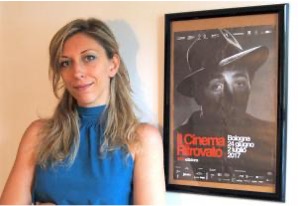
Sabrina Negri (Ph.D. 2017) is Assistant Professor in the Department of Cinema Studies & Moving Image Arts at the University of Colorado Boulder. Negri’s dissertation, titled “Archival Clues: Film, Digital, and the Evidential Paradigm,” speaks to the rich intersections of her work on the digital preservation of analog moving images, but she has also published articles on Italian cinema and Alfred Hitchcock, among other topics. Her film scholarship and teaching is deeply informed by her work as a preservationist and archivist.
This fall, Negri taught Film History I and an advanced seminar on Film Archiving and Preservation. The first, a large lecture class, had to be modified quite a bit for the remote teaching format. Similar to the format of film history courses at UChicago, CU Boulder students typically attend two lectures and two screenings per week. Knowing that this schedule was too intense for an online setting, Negri condensed the material into one pre-recorded lecture and one online screening per week. She also held optional weekly discussion sections on Zoom, which she really enjoyed. As she reflected on the course, “Even though nothing can take the place of in-person teaching, being online has its advantages: our library worked hard to enrich our selection of titles available for streaming, which allowed me to share optional films with my students. They were very grateful to have a curated selection of movies to watch during their long weeks of isolation. They even enjoyed silent films – or, at least, that’s what they told me!” she laughs.
Negri did not have to adapt her Film Archiving and Preservation seminar quite as much. “Luckily, our Preservation lab stayed open throughout the semester, so the students could learn the hands-on aspects of the discipline despite the closure of most of the campus.” Negri held lectures and discussions on Zoom, but with a small group of students, she reports that the dynamics were not so different from those of an in-person classroom. “Generally speaking, I think that what everyone missed the most was being able to watch movies all together on a big screen,” she says. “And this might be a very good sign for the future of cinema.”
The source of inspiration for the Preservation seminar was Negri’s own experience as a preservationist. Negri is a graduate of the L. Jeffrey Selznick School of Film Preservation at the George Eastman Museum in Rochester, N.Y., and she worked for three years as a preservationist at the film archive of the National Cinema Museum in Turin, Italy. “What I like most about film preservation is the detective work that can be done on each print in order to find out where it comes from, who handled it, how it ended up where it was found, and more,” she says. “I teach my students how to handle and repair prints, but also how to identify useful clues when inspecting them. I always give my class a detective assignment, as I call it, asking them to reconstruct the history of a print by inspecting the print itself.” She was glad that her students had access to a lab this term, as they were thrilled by their discoveries that came out of the detective assignment. “One student was able to identify a small film reel as found footage that Phil Solomon used for one of his films.” Beyond a part of the history of experimental cinema, that discovery matters for the institution as well. Phil Solomon (1954-2019) was Professor Emeritus at CU Boulder, following from and working with Stan Brakhage (1933-2003), who was Distinguished Professor of Film Studies at CU Boulder, to build a new avant-garde cinema out of the university.
Teaching preservation in Fall 2020 has given Negri plenty of chances to reflect on how COVID-19 is impacting film preservation. “From what I’ve seen, COVID forced archives to speed up a process that had been going on for years—that of digitization. In particular, the closure of movie theaters has fostered a broadening of the offering of digitized archival holdings online, often for free and with really interesting results.” The George Eastman Museum is one example: their website contains a selection of their digitized collection, where each title is introduced by the professionals who worked on its preservation. “This approach can be very fruitful,” she remarks, “insofar as it narrows the gap between the archive and the general audience. It creates a form of ‘soft curatorship’ where the institution opens its doors and offers guidance, but the final selection is up to the spectator—I refuse to adopt the term ‘user!’ I believe that the educational mission of film archives is exactly this—to guide the audience but give them freedom of choice.”
As far as Negri’s own educational mission, she has brought several traditions that she learned as a CMS Ph.D. student with her to CU Boulder. Among them are the desire to push students to think critically and the emphasis on close analysis as the first step towards the knowledge of cinema. “Most importantly, I would not have learned how to approach a practical problem with a theoretical framework had it not been for CMS, and that mindset has shaped both my research and my teaching more than words can express,” she says. “Finally, CMS faculty taught me that I can learn from my students: seeing the world’s top scholars engage with their class with genuine curiosity and enthusiasm was incredibly instructive and heartwarming.”
Leave a Reply